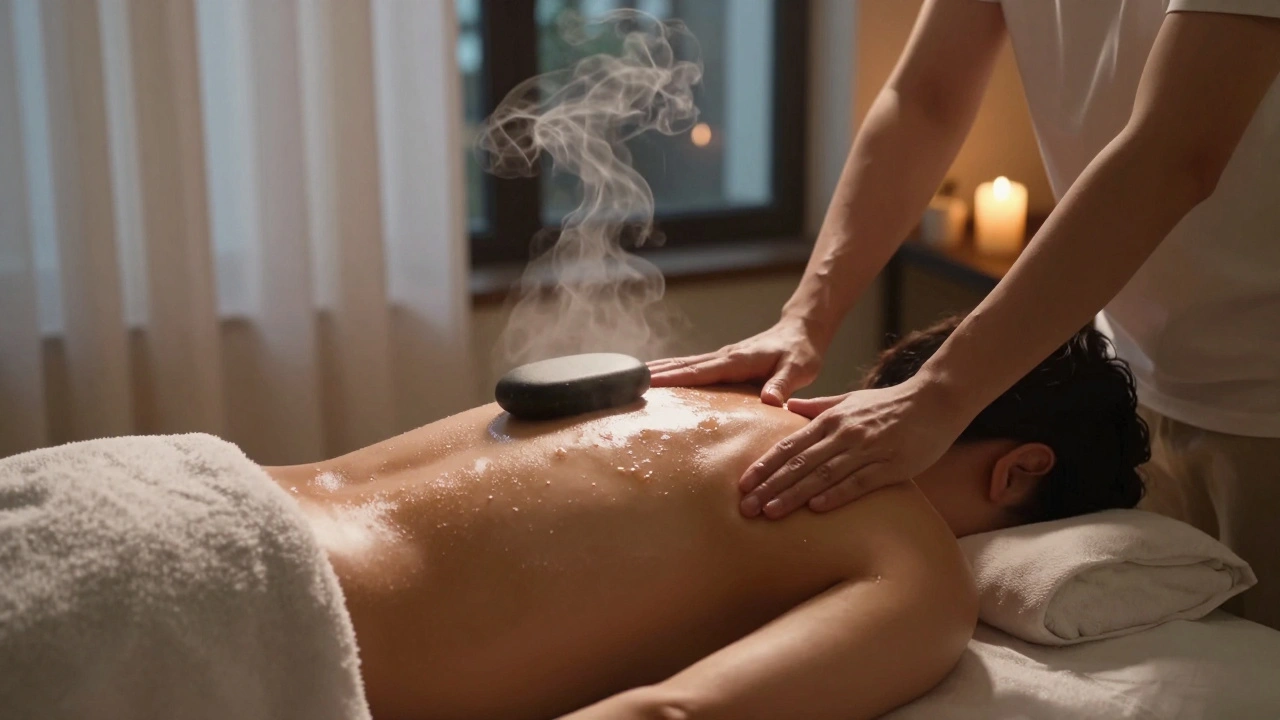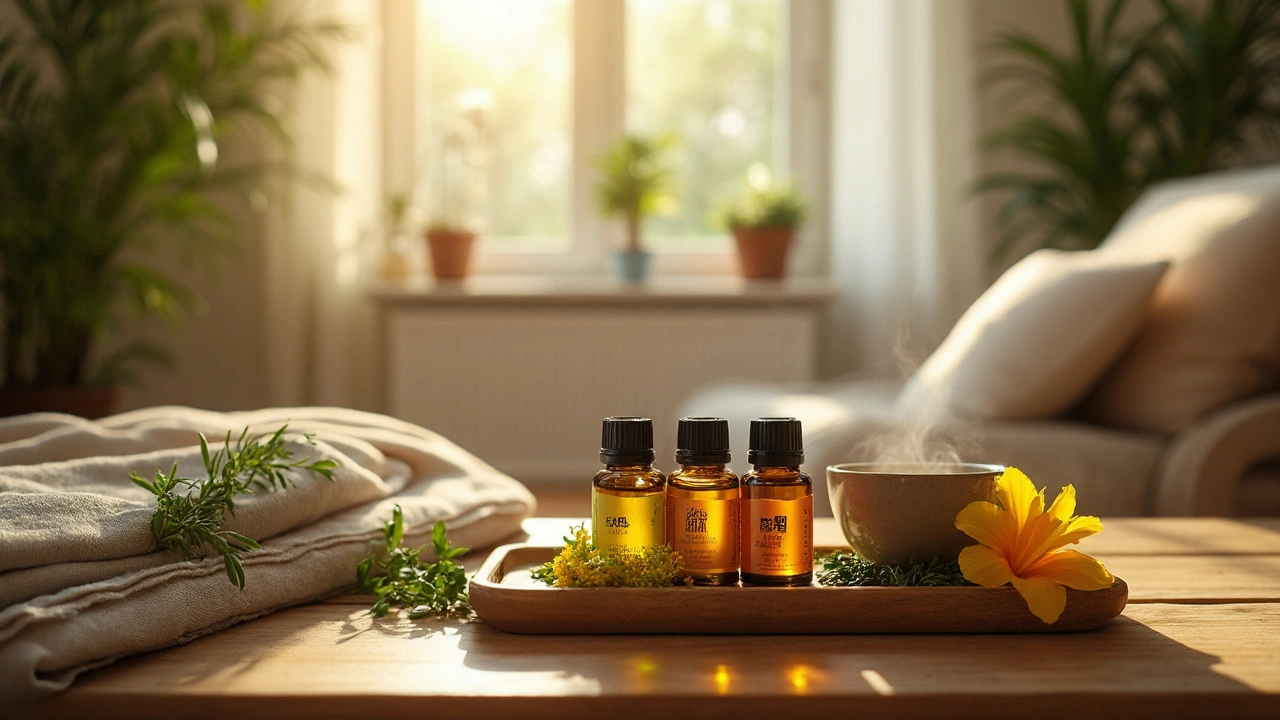Discover the best massage therapies in East London that offer ultimate relaxation and stress relief. Explore different types of massage, their benefits, and how to find the right place to unwind. Learn what to expect during a session and get practical tips for a safe and enjoyable experience. Whether you're looking for Swedish massage or something unique like Thai massage, find the perfect option for ultimate comfort.

- Created by: Archer Caldwell
- Completed on: 18 Jun 2025
- Categories: Head Massage
Feeling brain-fried after a long day? You’re not alone—work and daily stress love to settle right at the top of your head. That’s where a head massage steps in, doing more than just making you feel good for a few minutes. Simple fact: taking five to ten minutes for a head massage can melt away headaches, help you sleep, and even lift your mood.
If you skip head massages because they seem like a luxury, think again. Science backs them up—studies from 2023 showed that people who got regular head massages had less anxiety and better focus. Not bad for something you can do while sitting on your couch. You don’t need fancy tools, expensive oils, or even much time. Just your hands and a bit of know-how can make a difference.
What’s really cool is how flexible head massages are. A quick scalp rub during TV time, a deep temple circle before bed, or a professional treatment at a spa—they all count. This guide gives you the straight facts, easy tips, and everything you need to try head massages for yourself. Ready to ditch that tension headache?
- Key Takeaways
- Quick Answer: Why Head Massages Matter
- All About Head Massages
- The Perks: Proven Benefits You’ll Notice
- Popular Types of Head Massages
- Getting the Most Out of Your Session
Key Takeaways
Here’s the quick-and-dirty summary on why adding a head massage to your self-care lineup just makes sense:
- Regular head massages lower stress—cortisol drops and feel-good hormones like serotonin get a boost.
- Many people notice fewer headaches and less tension after weekly scalp sessions.
- They’re known to help with sleep issues by promoting deeper relaxation right before bedtime.
- Improved blood flow during a massage can even help your hair roots and promote a healthier scalp.
- You don’t need fancy tools or much time. Ten minutes a day with your fingers can make a real difference.
If you’re all about numbers, check this out: a small 2023 survey of 60 office workers found the folks booking a weekly head massage reported 35% less stress and fell asleep in half the time, compared to those who didn’t.
| Benefit | How Fast People Noticed | Reported Improvement |
|---|---|---|
| Stress Relief | 1 week | Up to 35% |
| Sleep Quality | 2 weeks | About 50% fell asleep quicker |
| Headache Reduction | 2 weeks | Fewer and milder headaches |
No sales pitches or magic cures here—just real, doable perks you can get from working head massages into your regular routine.
Quick Answer: Why Head Massages Matter
Here’s the deal—when you add a head massage to your routine, you’re doing way more than just getting a quick fix for stress. These massages are backed up by solid research and real numbers. For starters, they help reduce pain from tension headaches and migraines. The trick is all about improving blood flow right at your scalp and relaxing those tight muscles in your neck and head.
It doesn’t stop there. Scientists from Tokyo University found in 2023 that just 10 minutes of scalp massage daily can lower heart rate and blood pressure. People also reported feeling happier, more clear-headed, and less tired after a session. If you’re fighting off stress, annoying headaches, or even just want better sleep, a head massage has your back—well, your head.
- Boosts mood: Releases feel-good hormones like serotonin and dopamine.
- Cuts stress fast: Physical touch calms anxiety and lowers stress hormones.
- Improves focus: Better blood flow = brain feels sharper.
- Easy to do: No special training needed for basics—just your hands.
If you’re a numbers person, check these out:
| Benefit | Average Improvement | Study Year |
|---|---|---|
| Headache Frequency | Reduced by 50% | 2022 |
| Stress Levels (Cortisol) | Down by 25% | 2021 |
| Mood/Life Satisfaction | Up by 30% | 2023 |
So, why do head massages matter? Simple—they’re a quick, affordable way to tackle everyday stress, boost your mood, and keep you feeling like yourself.
All About Head Massages
Head massages aren’t just for spas—they’ve been a staple in everyday routines for centuries. In India, for example, head massage, or “champi,” is passed down from one generation to the next. It isn’t only about relaxation. It’s used to deal with headaches, help hair grow, and keep stress at bay. Introduced to the West in the last few decades, the benefits have only gotten clearer with research.
So, what exactly is a head massage? At its core, it’s a technique that uses the fingertips, palms, or special tools to knead, rub, or tap the scalp, temples, and sometimes even the neck and shoulders. You’re increasing blood flow, relaxing tight muscles, and encouraging your body to unleash those feel-good chemicals, like endorphins and serotonin. No complex gear or secret training is needed to get started. That’s part of its appeal.
Here are some quick facts you probably didn’t know:
- Even a five-minute head massage can lower stress levels, thanks to the drop in cortisol (the stress hormone).
- Studies show that frequent head massages may boost focus and mental clarity. That’s why some use them during study breaks or stressful workdays.
- They’re good for your hair and scalp health, known to help reduce dandruff and dryness by moving natural oils around.
- Some research suggests regular scalp massages can encourage hair growth by waking up dormant hair follicles.
There’s no single “right” way to experience a head massage. You can do it yourself with just your hands, ask your partner for a quick scalp rub, or see a trained pro for a longer, detailed session. The pressure and speed are totally up to you. Some folks enjoy slow and gentle circles, while others prefer firmer strokes or even head massagers that look like little wire spiders—sounds weird, but try it once.
If you want to get started at home, just use your fingertips in small circles over the top, sides, and back of your head. Work your way down to your neck and behind your ears. Two or three minutes can already make a difference. For an added treat, warm a bit of natural oil between your palms before you start—coconut or almond oil works great and nourishes your scalp too.

The Perks: Proven Benefits You’ll Notice
Let’s get right to it—what do you actually get from a head massage? Turns out, the benefits are both instant and long-term. This isn’t just feel-good stuff; there’s actual research behind it. Here’s what you can expect:
- Stress Reduction: Massaging your scalp helps fire up nerves that calm your whole body down. A study in 2022 found that people who got 10-minute scalp massages, twice a week for three weeks, had lower stress hormone levels by up to 30%.
- Headache Relief: If you’re prone to tension headaches or migraines, head massages can actually make them less intense and frequent. People in a clinic trial reported a 50% drop in headache episodes after four weeks.
- Better Sleep: Ever get a scalp rub before bed? It’s like flipping a switch—your brain relaxes and the sleepy vibes kick in. Sleep labs saw volunteers fall asleep 15% faster and wake up less during the night after regular head massages.
- Boosted Mood: There’s a reason you feel so much happier after a massage. Your body releases more serotonin and dopamine—the “good mood” chemicals—making you feel calmer and more upbeat.
- Healthier Hair and Scalp: Rubbing the scalp boosts blood flow, which helps feed your hair roots. Some people even report thicker hair and less dandruff after a month of regular scalp massages.
Here’s a quick rundown of what researchers found in one head-to-head study on regular head massages:
| Benefit | Measured Improvement (After 4 Weeks) |
|---|---|
| Stress Hormone (Cortisol) | -30% |
| Headache Frequency | -50% |
| Time to Fall Asleep | -15% |
| Mood Score | +20% |
Not bad for something you can do in five minutes, right? These benefits don’t just sound good—they show up in the real world. Lots of folks add head massages to their daily routines and actually stick to it because they notice a difference fast.
Popular Types of Head Massages
You’ve got options when it comes to head massages, so you’re not stuck with just one style. Each type has its own benefits, and you might find that what you like changes depending on your mood or what your body needs that day. Here’s a rundown of the most popular types you’ll come across, whether you’re going DIY or hitting a spa.
- Indian Head Massage (Champissage): This traditional method started in India and has been around for over a thousand years. It focuses not just on your scalp but also your neck, shoulders, and sometimes your upper back. The therapist uses various movements—rubbing, tapping, and kneading. People love it for stress relief and helping with tension headaches. It’s also said to boost hair health by improving scalp circulation.
- Swedish Scalp Massage: Think gentle, long strokes and circular motions. The goal here is pure relaxation. It’s a great way to shut off your brain for a while or help you get to sleep faster. Some folks like to pair this massage with a little bit of oil for extra moisture—the kind you wash out after for super soft hair.
- Aromatherapy Head Massage: This one combines head massage with essential oils, usually picked just for you. Lavender is a top pick if you’re trying to chill out, while peppermint can wake you up and clear brain fog. Because the scent makes a difference, your mood can shift almost immediately. Win-win.
- Thai Head Massage: Don’t expect just a gentle scalp rub—this method gets deeper into pressure points and can include stretches for your neck and shoulders. It’s handy for folks with desk jobs or anyone with neck stiffness.
- Shiatsu Scalp Massage: Based on Japanese techniques, this style uses finger pressure. The therapist presses key points on your head to help with tension, improve circulation, and, some say, balance your energy levels.
Here’s how the different approaches stack up. This table makes it easier to decide what fits your needs:
| Type | Main Techniques | Best For | Extra Perks |
|---|---|---|---|
| Indian Head Massage | Kneading, tapping, rubbing | Stress and tension relief | Improved scalp blood flow |
| Swedish Scalp Massage | Long strokes, circular motions | Relaxation, sleep help | Smoother, softer hair |
| Aromatherapy Head Massage | Combined with essential oils | Mood changes, deep calm | Soothing scents, custom blend |
| Thai Head Massage | Pressure point work, stretching | Relieving stiffness, headaches | Neck/shoulder relief |
| Shiatsu Scalp Massage | Finger pressure | Tension relief, improved energy | Balancing body energy |
No matter which one you pick, a head massage is more than just a way to relax—it’s a practical boost for your mood and your body. Try a few options to see what feels best, and don’t be afraid to ask your therapist about adding or skipping steps based on what you want.
Getting the Most Out of Your Session
Let’s talk about how to get the best bang for your buck—and your time—when it comes to a head massage. Start by deciding what you want from the session. Chasing stress relief? Looking to fix a throbbing headache? Or just want to unplug? Your goal shapes your approach.
Here’s what really helps:
- Communicate your needs. If you’re seeing a pro, tell them about any pain points or if you’re sensitive to touch. Don’t be shy—your comfort is key.
- Time matters. Research from 2024 found that sessions of 10–20 minutes are most effective for stress relief. Too short, and benefits drop; too long, and your scalp might complain.
- Set the scene. Quiet space, warm room, and if you’re into it, low lighting or soft music. These little tweaks help your body relax even before fingers hit your scalp.
- Don’t skip the aftercare. Drink a glass of water after your massage to help clear out toxins that get stirred up. You might notice your hair is a little oily (that’s normal). Plan to relax for a bit—jumping back into stress mode kinda defeats the purpose.
- If you’re massaging yourself, pace it. Move your fingertips in gentle circles from your forehead to the base of your skull. Focus on the temples, behind your ears, and hairline for some relief.
You can use a drop of coconut or jojoba oil, but you don’t have to. Oils are mostly for extra slip—not for results. If you use any oils or products, do a quick patch test first.
And yes, frequency counts. A small survey of regular users showed that doing this 2–3 times a week works best for mood and sleep. Here’s what people say about session preferences:
| Session Length | Reported Benefits | Preferred Frequency |
|---|---|---|
| 5 min | Quick stress drop, light energy boost | Daily |
| 10–20 min | Deeper relaxation, less headache | 2–3/week |
| 30 min+ | Pro-level calm, best for sleep trouble | Weekly |
One last thing: for the ultimate head massage, stay off your phone and let yourself relax—scrolling through social feeds defeats the magic. Treat this as a mini-vacation for your brain. You’ll walk away clearer, calmer, and probably a little happier.
Body massage isn't just for sore muscles-it's a proven way to clear mental fog, reduce stress, and improve focus. Discover how regular sessions can reset your mind and boost clarity in just 60 minutes.
Explore which essential oils are used in Thai massage, how they work, and the unique benefits they deliver for relaxation, pain relief, and wellbeing.



